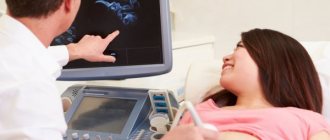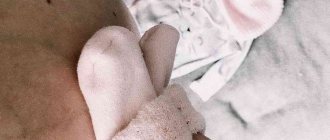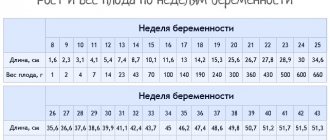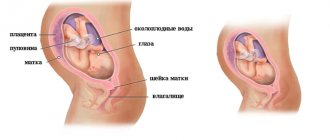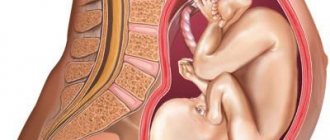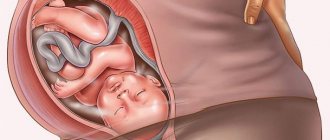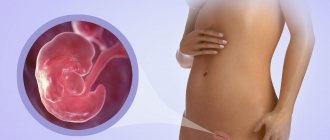Rating: 5/5 (4)
The 13th obstetric week of pregnancy is exactly that period of pregnancy when the expectant mother can safely go to the store for new clothes, because most of the wardrobe by this time is simply small.
the woman’s mood and well-being improves just as smoothly . Every day the attacks of vomiting, dizziness and nausea are receding more and more. In a word, life is starting to get better: I want to dance, draw, sing, and spend more time with family and friends.
Your baby is the size of a peach . Now his body will rapidly develop and grow, so it will be 3-4 times the size of his head by the end of pregnancy. The photo shows the rapid development of the baby at 13 weeks.
The thirteenth week is the time when you need to think only about good, bright things, enjoy life and tune in to a positive wave!
What happens to the baby at 13 weeks of pregnancy
Inside the uterus, a tiny organism continues to grow and develop. Every day he acquires new skills, grows, and gains weight. He becomes more and more like a man. His proportions and tiny face change.
Fruit size and weight
The baby’s length according to the CTE at week 13 is 6.5-10 cm. He will grow rapidly throughout the second trimester. The baby reached a record weight of 15-20 grams. This parameter will increase faster in the third trimester. These height and weight indicators are not yet great, but they are normal. It's only begining!
Fetal development
In parallel with the increase in height and weight, the baby is developing rapidly. He is expanding his skills. Its structure becomes more complicated:
- the brain continues to improve and increase in size;
- head growth slows down a little and the proportions begin to approach those of a newborn. The bones of the skull are strengthened;
- baby teeth (20) have completed their formation;
- the skin pattern on the finger phalanges becomes individual;
- the facial muscles responsible for sucking continue to develop;
- lip movements appear ;
- the larynx has finally formed the basis. It is she who will subsequently help the baby make sounds;
- the eyes continue their movement towards the nose from the lateral surfaces of the skull. Their original place is occupied by the ears;
- in the intestine increases. It fits in the abdominal cavity;
- The pancreas produces insulin. Thanks to this hormone, the metabolism of glucose and glycogen in the body is regulated;
- the synthesis of blood cells continues in the liver, bone marrow, and spleen. The formation of B lymphocytes begins. They are synthesized in the spleen and will become the basis for the baby’s resistance to infections;
- There are already about 2 million eggs in ovaries The prostate gland of boys is actively developing;
- sense organs are actively working. The baby sniffs the amniotic fluid and tastes it. Right now he is getting used to his mother’s diet. If you consume some foods during pregnancy and others after childbirth, there is a high risk that your baby will refuse to breastfeed. Therefore, it is recommended to adhere to proper nutrition, which will continue after childbirth;
- Arms and legs are growing . Their muscles become larger and stronger.
Medical supervision
Surely you are already registered at the antenatal clinic. Then you already have a plan for examination and testing. Visit the necessary doctors regularly. When donating blood, be sure to follow the preparation conditions, otherwise the result may be incorrect.
If you have not yet had your first scheduled ultrasound, you will be scheduled for one. You will be able to look at your baby, but you are unlikely to find out the sex of the child.
Ultrasound photo:
If you are diagnosed with a serious illness that can be treated with antibiotics, your doctor may prescribe them. The placenta is so developed that it will protect the baby from the side effects of this group of drugs.
What happens to mom at 13 weeks of pregnancy
With normal well-being after a difficult first trimester, expectant mothers begin to feel the joys of future motherhood. Hormones continue to rage in a woman’s body. This may externally manifest itself as light pigment spots on the face. The color of the nipple and halos may also change. The line connecting the pubis and navel continues to darken. The first tiny discharges of colostrum may begin. If this is the case, you need to take care of comfortable underwear of the right size. It must be made of natural fabrics, otherwise it will not be possible to avoid scuffs.
Uterus size
The size of the uterus at 13 weeks depends on many reasons. The main ones are:
- the correctness of processes during pregnancy;
- the number of growing fetuses in the uterus;
- presence of infectious pathogens.
In a normal pregnancy, if there is one fetus in the uterus, its standing height (HH) is determined to be 11 cm. In a multiple pregnancy, this figure will be higher and will directly depend on the number of babies in the uterus.
Feelings at 13 weeks
What, besides joy from past toxicosis, can an expectant mother feel? The main sensations may be:
- Reducing trips to the toilet is also a great joy . The uterus now takes up more space in the abdominal cavity and puts less pressure on the bladder. This is why a woman stops emptying her bladder so often.
- Heartburn. A burning sensation or warmth behind the breastbone may appear later. However, those who experience heartburn this early should urgently optimize their diet. A banana in your purse, cottage cheese in the refrigerator at work, etc. will become worthy snacks. Small healthy meals excluding fried and fatty foods will help get rid of heartburn;
- Increased appetite . A woman who ate poorly and felt constant nausea in the first trimester has a huge temptation to eat everything at once! And, at first glance, she should start eating more. No matter how it is! It is precisely when suffering from a voracious appetite that you need to limit yourself. It is very difficult. For proper nutrition, you need to divide your daily food into 5-6 meals. While eating, do not be distracted by watching TV. Eat slowly. Only this behavior will help not cause digestive disorders during this period. In a later period, this will not lead to overeating and excess weight gain.
- Heaviness in the legs. It seems that with such a tiny increase in weight, the legs cannot get so tired. But here again hormones play their role. They provoke fatigue, heaviness, and sometimes even nagging pain in the legs. In this case, comfortable shoes will help. It is advisable to give up heels - while maintaining your health, you will still have time to show off in stiletto heels after giving birth.
Mom's weight at 13 weeks, permissible increase
The baby is growing, and the expectant mother is adding weight. How much should you weigh? Weight gain and loss at 13 weeks , as in previous periods, will depend on how much the woman weighed before pregnancy. For thin ladies with a Body Mass Index (BMI) less than 19.8, an increase of 2.35 kg over 13 weeks will be considered normal. They gain more actively than their larger friends with the same weight. With a BMI of 19.8-26, the acceptable weight gain will be 1.7 kg. If the initial BMI was more than 26, then the desired increase would be 0.95 kg. With this ratio, thin women will gain about 15 kg during a normal pregnancy, and large representatives of the fair sex will gain only 9. This becomes clear if we remember that weight gain is not only due to the fetus, amniotic fluid, placenta, etc. , but also due to stored fats for breastfeeding.
Other indicators of weight gain will occur during multiple pregnancies. The more babies are expected, the more weight the mother will gain.
Recommendations
The main advice now is to love yourself, your body and your child. During your term, you need to become even more careful in everything.
- Meat or fish, eggs, fruits, vegetables, cereals and dairy products - this is your daily diet.
- It is advisable to have four or five meals a day.
- Remove the skin from the chicken and do not eat it.
- If you have a sweet tooth, buy marmalade, marshmallows, marshmallows (without dyes), dried or dried fruits. Forget about buns and cakes. If you really want chocolate, eat one or two slices.
- Try to 100% avoid fried foods, smoked foods, canned foods, and spicy foods.
- Don't drink strong tea and coffee if you love these drinks and can't give them up. But if you have low blood pressure, your doctor may recommend coffee.
- There is an opinion that the expectant mother should definitely get calcium from vegetables, and not from animal products. It is argued that animal calcium causes early ossification of the fontanelles on the fetal head and then complicates childbirth. This is just another myth. During pregnancy, it is very difficult to oversaturate the body with calcium, since you really need a lot of it. The source of this microelement does not matter at all. And the fontanel in children closes only closer to the age of one.
- If you have constipation, give up rice and be sure to include dried apricots and prunes in your diet. Dried apricots will also help with cramps, as they contain potassium.
- As always, alcohol and smoking are prohibited.
- Walk more often in parks, near rivers, ponds and fountains. There is an opportunity to travel outside the city - just wonderful.
- At your dacha or personal plot, of all agricultural work, you can only pick berries, and not for long and while sitting.
- If your legs hurt from long walks, walk more slowly and for short distances.
- Do yoga, swimming or special gymnastics. You need to prepare for the upcoming birth now.
- Join any club for pregnant women, communicate, share experiences, help each other, at least via the Internet.
- Talk to your baby, stroke your belly and think about good things.
- If you feel stuffy at work or at home, ventilate the rooms or go outside when possible.
- If you have a blood pressure monitor at home, measure your blood pressure in the morning and evening and write down the readings. If there are deviations from your individual norm, show the records to your doctor.
- Lubricate your chest, stomach and thighs with stretch mark creams or just olive oil.
- Dress so as not to freeze or overheat. If the weather outside is unstable, use several layers of clothing. During warmer months, carry an umbrella with you.
- There are no restrictions on sex if you have one fetus and there is no risk of miscarriage.
13 weeks of pregnancy is a time of joy and positive emotions. Be calm and happy - the second trimester awaits you.
← Week 12 Week 14 →
Belly size at 13 weeks of pregnancy
The long-awaited time has come when the tummy no longer hides its interesting tenant. Nowadays, most expectant mothers are asked about pregnancy. Some have already had to change their clothes to more spacious ones. Some people make do with the old one. Whether you decide to purchase a “maternity wardrobe” or stick to regular models, do not allow your belly to shrink or tighten. This may impair the baby's blood supply.
The abdominal circumference is measured by the gynecologist at each examination. This indicator in the second trimester will indirectly indicate an enlargement of the uterus. The doctor will be most interested in seeing the rate of increase in abdominal girth. In later stages, this indicator will help calculate the expected weight of the child.
The increase in centimeters, as well as a woman’s weight, will depend on her constitutional characteristics and weight before pregnancy. This is a strictly individual indicator. When measuring it, the following rules must be observed:
- The measurement is made with a flexible measuring tape.
- Measurements are taken in a supine position with the knees extended and the knee and hip joint extended. In this case, there will be constant stretching of the abdominal wall and the condition of the spinal column.
- Each measurement should be taken after emptying the bladder. In this case, it will not cause errors when recording data.
- To get a true reading, the tailoring tape should go from the deepest curve of the spine to the navel.
The tape should fit snugly against the skin, but not cut into it.
Uterus
The baby is growing and the uterus, its container, is also increasing in volume. For most women, it extends beyond the pelvis. In this case, the norm for the height of the uterine fundus is fixed at 11 cm. Of course, this figure will be correct only if there is 1 baby in the uterus. If the pregnancy is multiple, then it may be larger. Pregnancy with twins at 13 weeks will be manifested by an increase in the height of the uterine fundus by 0.5-1 cm.
Discharge
Most indicators of well-being improve from the first days of the second trimester. However, this may not apply to discharge. Even ordinary (transparent, viscous, odorless) odorless discharge can become even more abundant.
Discharges that differ from normal are a sign of existing problems:
- Curdled white discharge during pregnancy is often a sign of thrush. They are abundant, with a sour smell. In addition to the discharge, there is a burning and itching in the vagina, which intensifies in the evening. In this case, pain may occur during sexual intercourse. The question of treating or not treating thrush should not arise. A clear decision to sanitize the vagina is made in the second trimester.
- If the discharge is yellow or green , profuse, or with an unpleasant odor, you should consult a doctor. The accompanying itching, burning, soreness, and increased body temperature indicate an inflammatory process. Its appearance is based on an infectious agent. Don't put off treatment for too long. Help your baby grow up in favorable conditions. Yellow and green discharge is a sign of inflammation of various origins. This color can appear with staphylococcal or gonococcal infections. They can be provoked by E. coli and Trichomonas. Signs of inflammation with them can be the same: itching, burning, redness, rise in temperature. The only way to get rid of the disease is to carry out full treatment.
- The appearance of blood in the discharge is the most dangerous symptom. If it is detected, you must immediately seek medical help. Bloody, including brown, as well as pink and beige discharge can be a sign of various pathological conditions. The most dangerous of these is premature termination of pregnancy. Therefore, do not delay your visit to the doctor - take care of your health.
Pain at 13 weeks of pregnancy
Painful sensations warn of serious changes in the body that require treatment. That is why they frighten pregnant women so much. The first trimester is behind us and panic at the slightest change in condition is no longer observed.
If there is nagging pain on the sides of the abdomen (usually on the right), the pain is localized in the sacrum and coccyx , and in a sitting or lying position it decreases or disappears, then this sensation only indicates the body is intensively preparing for further pregnancy and childbirth. The ligaments of the uterus, as well as the connecting bones of the pelvis and spine, change. They soften and stretch. This causes pain.
In this case, you need to sit or lie down and relax. Sometimes rubbing your back helps. The stomach hurts and pulls, the chest is enlarged and hard, the lower back makes itself felt with every movement. There's nothing to worry about. This is pregnancy. Just like a temperature of up to 37°C at the 13th week of pregnancy , such pain is normal.
What pains can be dangerous?
If the pain is intense, forces you to wake up, immediately stop what you are doing, or differs from what was previously observed, you need to consult a specialist. Especially if they are accompanied by other symptoms:
- A sore throat may be accompanied by fever, weakness, and difficulty swallowing.
- Stomach pain may begin with heartburn, nausea or vomiting. It can occur after a certain period of time after eating.
- Pain in the right side can be combined with abnormal stool, nausea, and bitterness in the mouth.
- Pain in the ovary may be accompanied by pain in the ligaments of the uterus and be a normal manifestation of pregnancy. However, its appearance in combination with an increase in body temperature, foul-smelling vaginal discharge, itching and discomfort is not normal and requires medical attention.
- If your stomach hurts along with frequent and painful urination, vomiting, fever, vaginal discharge, this is also a sign of a disease that requires treatment.
- Hip pain is quite common during pregnancy. In most cases, it occurs against the background of hormonal changes, mechanical pressure of the fetus and insufficient calcium absorption. In this case, pain should be perceived as an individual manifestation of pregnancy and rest more. However, if the pain occurs against the background of an existing joint disease, injury, accompanied by fever, rash and pain in other joints, this may be a sign of a disease and in this case treatment is required.
- If your back and this leads to a significant limitation of mobility (inability to turn, bend, etc.) or there is an increase in temperature, rashes, cough, you should consult a doctor.
- Headaches can occur when blood pressure changes due to hormonal changes. We try to prevent them by avoiding sudden movements, proper physical regimen and nutrition. If your head hurts along with a fever, cough, runny nose, etc., this is a sign of a disease that requires the attention of a specialist.
Tests and studies at 13 weeks of pregnancy
The second trimester begins and during this period its own issues arise that must be monitored. The following studies will help resolve them:
- Blood test (general) with protein determination.
- Blood test (general).
- Blood test with determination of coagulogram, lupus anticoagulant, antibodies to phospholipids, to hCG.
- Blood test to determine antibodies to the causative agent of rubella, toxoplasmosis, herpes, CMV infection.
- Smear and PCR for infections.
- Blood test to determine antibodies to Rhesus and group types in case of incompatibility. Ultrasound.
Frozen pregnancy at 13 weeks
Cessation of fetal development in the second trimester is much less common. However, due to infections or other reasons, this can happen. The danger comes from a situation where no signs of pathology are detected. Then there is a danger of missing the fading of pregnancy and identifying it at the stage of intoxication.
Cessation of fetal development can be manifested by a sudden cessation of all complaints that appeared during pregnancy (including chest pain), cramping abdominal pain, and vaginal discharge (bloody or purulent). These symptoms should promptly consult a doctor. Therefore, to the question: “ What to do if your chest stops hurting ?”, you need to answer unequivocally - consult a doctor.
Double test: decryption
In the first trimester (from 10 to 14 weeks), the expectant mother must undergo the first prenatal screening (or double test). The purpose of this study is to calculate the risk of a fetus having a chromosomal pathology. It is impossible to make an accurate diagnosis (for example, Down syndrome) using this analysis. To diagnose genetic diseases, more serious studies are required, involving the collection of umbilical cord blood or biopsy material from the fetal membranes.
The double test involves determining the concentration in the blood of a pregnant woman of a special plasma protein (associated with pregnancy) and free human chorionic gonadotropin. The release of these substances occurs in all expectant mothers through the membranes of the fetus. In some pathologies (Down syndrome, Edwards syndrome, patent neural tube), the level of determined indicators differs significantly from the norm. However, this can also occur under other conditions (for example, threatened miscarriage, delayed fetal development), as well as when taking medications (in particular gestagens, which are prescribed to many pregnant women who have problems with bearing a fetus).
The figures obtained during the double test in laboratories are converted into MoM (generally accepted coefficient), which displays how many times this indicator differs from the average (median) for this period of pregnancy. Normally, MoM should be in the range from 0.5 to 2.0. Ideally, this coefficient should approach 1. Next, the received data is processed by a special program that gives the risk value in numbers, for example 1:250. The lower the number in the denominator, the greater the risk. That is, a risk of 1:100 means that for every 100 pregnancies with the same screening indicators, 1 baby is born with Down syndrome or another genetic pathology. When calculating the risk, the age of the mother and the presence of older children with chromosomal abnormalities must be taken into account.
In addition to the double test, prenatal screening in the first trimester necessarily includes an ultrasound of the fetus (determining the thickness of the nuchal translucency, the presence of a nasal bone and the coccygeal-parietal size). The results of prenatal screening are assessed by a gynecologist. If he discovers that the patient has a high risk of giving birth to a sick baby, he refers her to a geneticist for consultation.
